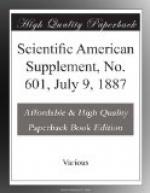We have now also so large a number of really good regenerative lamps which give excellent results, and can be made in a great variety of very neat and ornamental designs, that we ought to endeavor to the utmost of our power to introduce them to the public, and, if possible, induce them to use them not only in halls and similar places, but in their dwelling houses, as with these lamps a most thorough and efficient system of ventilation can be carried out, by which the heat that is so much complained of in gas-lighted apartments is reduced to a minimum, and the atmosphere of such apartments is rendered healthy and agreeable.
With such improved lamps at our command, I think we have nothing to fear from the competition of the electric light, which during the past year has not made any very startling advance—generally attributed by electricians to the restrictive legislation under which they have been placed. Let us hope this is now about to be removed. I am sure we all rejoice that such is the case, as all we want is a “fair field and no favor.” We can with confidence await the result.
THE WELSBACH GAS LIGHT.
In the mean time, however, while electricity for lighting purposes has, to say the least, not made any startling advances, we have, besides the regenerative lamps before mentioned, the new Welsbach light, which is exhibited before you to-day, by the kindness of Dr. Wallace; and if the results said to be obtained by it are at all what they are represented to be, we certainly have a new departure in gas lighting of no mean order. Dr. Wallace—a gentleman who is well known to us as one well qualified to test its merits—has found that the Welsbach burner produces a light equal to more than 9 candles per cubic foot of gas of 25 candle power, thus nearly doubling the amount of light compared with gas consumed in the ordinary way.
The construction and manufacture of the burner I have seen described in these terms: Chemists have been diligently working for many years on the problem of how to convert into light the highly condensed heat of the Bunsen burner; and a Vienna chemist now claims to have solved it.
The first condition of the problem was to find a medium on which the heat could be perfectly concentrated and raised to illuminating power. Many experiments have been made with platinum in a Bunsen flame, and a brilliant enough light has been produced, but at a cost altogether outside commercial use. The Vienna chemist, Dr. Welsbach, has discovered a composition which is as good a non-conductor—that is to say concentrator—of heat as platinum, is much more durable, and a great deal cheaper. The base of it is a peculiar clay, found in Ceylon, which combines the indestructibility of asbestos with the non-conducting property of platinum; and having found the incandescent medium, he has next adapted it to the Bunsen burner.




